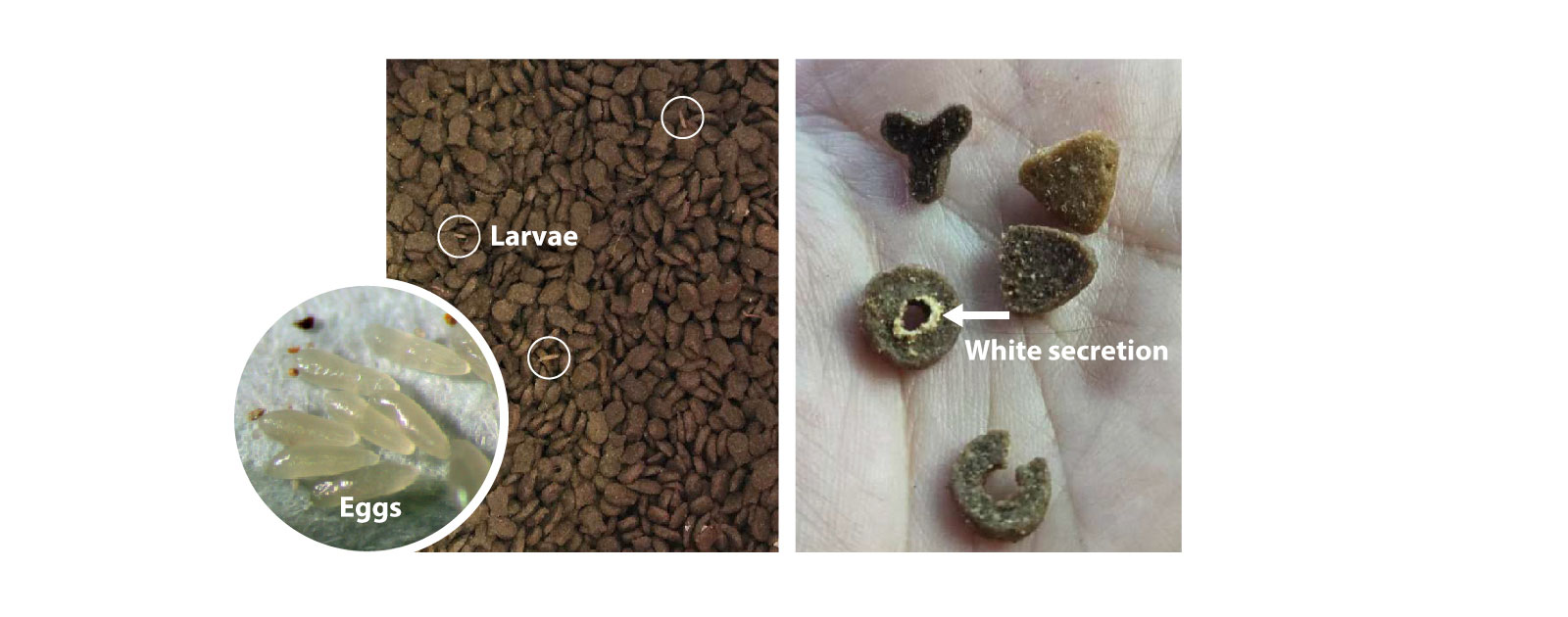
Red-legged Ham Beetle
The most common pest found in pet food in Taiwan is the red-legged ham beetle (Necrobia rufipes). It appears in black or brown, with adult beetles measuring between 3 to 6 mm in length.
It can be found throughout the year and prefers to hide in dry, dark places. Under temperatures of 25-35°C and relative humidity levels of 64-70%, the incubation period for eggs ranges from 4 to 12 days, while the larval stage lasts between 14 and 22 days. Upon reaching full maturity, larvae spin cocoons and undergo pupation. The entire life cycle from egg to adult takes approximately 25 to 30 days, and adult beetles have a lifespan of 28 to 63 days.

Adult beetles possess strong flight capabilities and primarily lay eggs at night in concealed locations such as walls, product packaging, or crevices between kibble. Eggs are typically laid in clusters, with each cluster containing around 30 eggs. Female beetles exhibit high reproductive capacity and extended egg-laying periods. Once larvae hatch, they consume the eggshells before boring into their host. Both adult beetles and larvae exhibit cannibalistic behavior and are also capable of preying on the larvae of other stored-product pests.
Adult beetles can penetrate dry food packaging by boring holes or gnawing through bags before laying eggs inside. White insect eggs may be found on the pet food, which hatch into larvae within four days.
Complete Life Cycle: 25-30 days (from egg to adult)

Causes of Insect Infestation in Pet Food Domestically and Internationally
Common Causes of Pest Infestation
- Storage Conditions: Poor storage conditions, such as high temperature, high humidity, or inadequate ventilation, can promote pest infestations. Ideal storage should be kept dry, cool, and well-ventilated.
- Packaging Damage: Improperly sealed or damaged packaging makes it easier for insects to invade and reproduce inside the product. Always check that packaging is intact when purchasing.
- Environmental Hygiene: If the storage area contains insect eggs or pests, pet food is more likely to become contaminated. An unclean environment further encourages pest reproduction.
- Extended Storage: Pet food stored for too long, beyond its expiration date, is more susceptible to pest infestation. It's advisable to purchase appropriate amounts based on actual needs.
Common Types of Pet Food Packaging
Packaging Type Comparison
- Composite (Laminated) Aluminum-Plastic Bags: Commonly used for small packages and premium dry pet food, offering excellent protection against light, moisture, oxygen, and pests. This type of packaging effectively blocks oxygen, moisture, and light, extending the shelf life of pet food while also preventing pest invasion.
- OPP Woven Bags and Multi-Layer Paper Bags: Impact-resistant and light-blocking but provide poor protection against moisture, oxygen, and pests. The outer bag is not fully sealed, and the thin PE inner liner allows oxygen and water vapor to penetrate, which can also lead to odor leakage and attract pests. These are commonly used for large, economy-sized pet food packages due to their good impact resistance.
Expert Reminder:
Once opened, pet food should be transferred to a sealed container and stored in a cool, dry place. For large packages of pet food, if they cannot be used up in a short period after opening, it's recommended to divide them into smaller portions to reduce the risk of contamination from repeated opening.
Prevention and Handling Recommendations
Purchase Considerations
- Choose reputable brands and sales channels
- Check that packaging is intact and undamaged
- Pay attention to production date and shelf life
- Avoid purchasing products close to expiration
- Buy appropriate quantities to avoid long-term storage
Correct Storage Methods
- Keep the environment dry, well-ventilated, and away from light
- Use sealed containers to store opened pet food
- Clean the storage area regularly
- Avoid placing on damp floors or near walls
- Regularly check pet food for any abnormalities
Handling When Pests are Discovered
- Immediately stop using contaminated pet food
- Thoroughly clean storage containers and storage areas
- Check other dry foods in the home for pest infestation
- Avoid storing new pet food in the same location for a short period
- Contact the manufacturer or seller if necessary
References:
- 農業部農業試驗所-農業病蟲害智能管理決策系統 | 病蟲害資料庫
- 中華民國第50屆中小學科學展覽會作品說明書-寵蟲危機-寵物飼料中赤足郭公蟲之特性與防治方法
